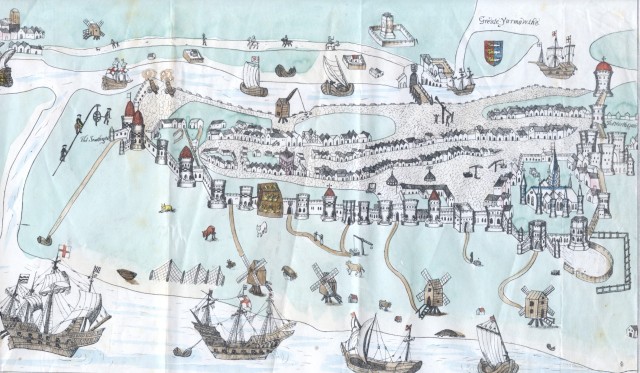I have spent nearly a decade of my life researching and writing about Great Yarmouth’s Civil War history, something which has been rewarding and endlessly fascinating because of the quality of Great Yarmouth’s civic records held at the Norfolk Record Office. My research has evolved from a study of the politics within the town to focusing on the context of Great Yarmouth’s 1645 witch-hunt, encompassing religious factions and violence in the 1620s and the town rising for the King in 1648. A profoundly important but mostly forgotten incident from this period is the town’s struggle with Royalist privateers between 1643 and 1646. The privateering had a low body count, but near destroyed the town’s fishing industry, precipitated a rebellion, and began the career of a great admiral. The Great Yarmouth Assembly Books held by the Norfolk Record Office are the primary source for the town’s politics during the early modern period. These books are the minutes of the meetings held by Great Yarmouth’s corporation, recording the Assembly’s membership, debts and decisions made. It is the seventh book in the series that covers the English Civil War and interregnum (NRO, Y/C 19/7). The growing crisis of piracy between 1642 and 1645 is recorded in the Assembly book by the increasing demands for support from the town’s Assembly to Westminster.
The herring industry provided employment for fishermen and attendant trades, additional income for citizens at the yearly herring fair, and was the basis for charitable funds. Herring fishing had been a vital part of Great Yarmouth’s economy since the town’s foundation, the connection symbolised by the town’s coat of arms, the three lions with fish tails, granted by Edward III in 1340. The herring catch supported a network of craftsmen in Great Yarmouth who equipped the vessels and provided the smokehouses, casks and salt to pickle Great Yarmouth’s famous red herring. The industry was tightly regulated by the Assembly who determined the yearly price of salt, provided cure masters to oversee the process, and inspected the quality of herring barrels.
Great Yarmouth’s herring fair was held annually between Michaelmas, 29th September and Martinmas, the 10th November. This forty-day fair enriched the town through the sale, transporting and loading of herring, the rights to which were restricted to freemen. The restrictions on strangers selling herring were circumvented by allowing freemen to host buyers and sellers, providing an additional income. The Assembly also had the right to half doles and heynings of the catch. The half dole was a percentage of any catch over two lasts granted to the Assembly. The heyning rate was paid by strangers to allow them to sell herring in the town. The money raised by half doles reached £334 10s 4d in 1642 and was used a charitable fund. The herring trade was vital for the livelihood of the town’s ordinary citizenry, but their reliance on a source of naval income left them vulnerable to threats from the sea.

Engraving from C.J. Palmer’s edition of Manship’s History of Yarmouth depicting a plan of the town and harbour of Great Yarmouth, c. 1570. NRO, Y/C 45/16
Civil War Privateering
The Great Yarmouth herring fleet was uniquely vulnerable in 1643 when the privateering began. At the outbreak of the English Civil War, the Royalists did not threaten the security of the North Sea, but they began contracting privateers to raid Parliamentarian shipping and catch the navy off guard. The Duke of Northumberland and the Lord Admiral the Earl of Warwick had secured the loyalty of the English Navy to Parliament in May 1641, and the King lacked ports to support a fleet when the Civil War broke out. The Royalists contracted privateers to supply their naval power, basing them out of captured ports in England and Wales, the Channel Islands, and Ostend where they could sell captured vessels. By 1644 the Earl of Warwick believed there were 250 royalist vessels under sail. The Royalist privateers dominated the North Sea between 1643-45 and their success allowed the privateers to pick their own targets of interest and opportunity, something Great Yarmouth was not prepared for.
It was Royalist privateers led by Thomas Allin, a merchant from Lowestoft with local knowledge and an enmity against Great Yarmouth, that threatened the town’s herring fleet. Allin was connected to the abortive 1643 royalist rising in Lowestoft, but he escaped from capture following the rising to join the royalist privateering fleet at Ostend. However, his pink was confiscated and sold by the Great Yarmouth Assembly while lying in the town’s haven. Allin and his crew of Lowestoft men formed a ‘confederacy against Yarmouth, to retaliate the injuries they had received from that town… with the design of fitting out vessels to distress the trade at Yarmouth’. He and his crew knew the route of the herring fleets and the vulnerable points of their annual fishing excursions. Thomas Allin’s campaign in 1644 captured twenty out of twenty-three vessels travelling to Iceland. Between 1643 and 1645 the half doles reduced to half their peacetime value and two-thirds their value in 1642. Allin claimed he had captured thousands of sailors from Great Yarmouth. Allin survived the war and ended up as an Admiral in the Restoration Royal navy, serving with distinction against the Dutch as an admiral. Great Yarmouth’s herring fleet was nearly wiped out in 1643-44, thousands of sailors were captured, and the catch precipitously low, which demanded action from the town to protect what remained.
Great Yarmouth responds
The Great Yarmouth Assembly moved to defend the herring fleet by appealing to Parliament for guard ships. It wasn’t until after the herring fleet had been mauled in the winter of 1643 that the Assembly requested guard ships from Parliament in the following summer. However, the Assembly sent two relatively inexperienced councillors, Walter Bullard who had only served the Assembly for three years, and Geoffrey Cobbe, whose civic career had been without distinction. The Assembly also expected the journey to Parliament to be funded by the ‘chiefe fishermen[‘s] … contributions’, rather than from the common purse. It took the intervention of Bailiff elect Thomas Johnson to get Parliament’s agreement for ships to defend the fleet as part of his own journey to Parliament. Parliament would provide a squadron of three ships supported by the town’s ship the Adventure. Following the heavy losses suffered by the herring fleet in the winter of 1644, the town sent the Aldermen Robert Gower and Giles Call in March 1645 to agree the next years’ wastage fleet, just after the arrival of the current fleet. When they returned with the promise of only three vessels, two more aldermen were sent out, William Lucas and Geoffrey Cobbe, and they secured five vessels in total. The town was slow to react initially, but the guard ships were an effective deterrent to further privateering.
The town provided its own warship to support Parliament’s fleet, a former merchantman captured whilst carrying troops and equipment to England, which the Assembly renamed the Adventure. The ship was initially equipped for ‘the takeing of such prize Shippes vessells [and] goods as belong to any p[er]sons or places that are in hostility against the Parliament’, and in 1643 it captured a ketch laden with coals and a pink carrying white fish. It was only as part of the Parliamentary orders to defend the herring fleet that the Adventure became part of the guard ships, and the Assembly put its own profit above the interests of the town’s fishermen. The Assembly had proved unable to curb the privateering before the herring fleet had suffered serious damage.
The Consequences of the Privateering
The privateering campaign and the near destruction of the Great Yarmouth’s herring fleet had a profound effect on the relationship between the governed and governors of the town. Great Yarmouth’s fishermen suffered through lost catch and having ‘thousands of prisoners’ who might have been ‘endungeoned, nay hanged’. The Assembly failed to support the sailors it had recruited for wastage service, twenty-one mutinying in December 1645, having not being paid for six months which required Edward Owner to step in and offer £100 to calm the mutineers. The Assembly also made life harder for the fishermen, preventing debtors from selling herring until their debt was paid to the Assembly, and preventing fishing on the Sabbath by closing off the harbour with the boom. This antagonism came to a head in 1648 where the disgruntled sailors lay behind a popular uprising.
Parliament was concerned in early 1648 that Great Yarmouth would suffer from a popular uprising and believed empowering the town’s Assembly was the key to preventing further unrest. The town was spending increasing amounts of money on relieving the suffering sailors, and in May 1648 the Assembly recorded that they were collecting a benevolence for the sailors who were ‘ruined in their estates [and] brought into great want [and] misery; by being taken at Sea in their fishing voiages by Rovers [and] pirate’. These discontented sailors were the basis for a popular rising against the town’s Assembly. The Committee of Both Houses reported to Colonel Scrope in July 1648 that ‘many Masters and Seamen are going towards Yarmouth to be ready there to ioyne w[ith] the Revolted Ships’. The poverty caused by herring piracy both produced a heavy burden for Great Yarmouth’s Assembly and led to popular discontent.
The Great Yarmouth Assembly book provides a detailed account of life in Great Yarmouth. The damage to the herring fleet is a powerful example of how a vital event in local history, with profound effects on peoples’ lives, can be forgotten. Thanks to the Norfolk Record Office these accounts are preserved, and more powerful stories are ready to be rediscovered.
Researched and compiled by Danny Buck, NRO Research Blogger
Sources
• Norfolk Record Office, Y/C19 Great Yarmouth Assembly book 6. 1623-1642 7. 1642-1660.
• John Adamson, The Noble Revolt (London, 2007)
• Ben Coates, The Impact of the English Civil War on the Economy of London, 1642–50 (Oxford, 2016)
• Ketton-Cremer, Norfolk in the Civil War
• Edmund Gillingwater and A. E. Murton, Gillingwater’s History of Lowestoft: A Reprint: With a Chapter of More Recent Events by A.E. Murton (Lowestoft, 1897)
• C. S. Knighton, ‘Allin, Sir Thomas, first baronet (bap. 1612, d. 1685)’, ODNB
• Michael James Lea-O’Mahoney, ‘The Navy in the English Civil War’ unpub. Ph.D thesis University of Exeter, 2011
• Thomas Moule, Heraldry of Fish. Notices of the Principal Families Bearing Fish in Their Arms (London, 1842)
• Thomas Nash, Nash’s Lenten Stuff Containing the Description and First Procreation and Increase of the Town of Great Yarmouth, in Norfolk: With a New Play, Never Played before, of the Praise of the Red-Herring. Fit for All Clerks of Noblemen’s Kitchens to Be Read; and Not Unnecessary by All Serving-Men, Who Have Short Board-Wages, and to Be Remembered. (London, 1599)
• Henry Swinden, The History and Antiquities of the Ancient Burgh of Great Yarmouth, in the County of Norfolk, Collected from the Corporation, Charters, Records, and Evidences, and Other Most Authentic Materials (Great Yarmouth, 1772)
• Robert Tittler, ‘The English Fishing Industry in the Sixteenth Century: The Case of Great Yarmouth’, Albion, 9 (1977)













